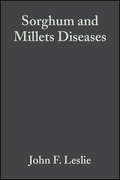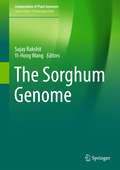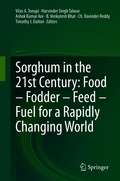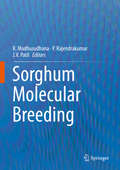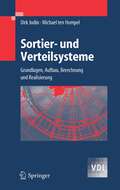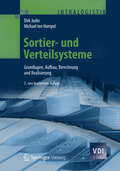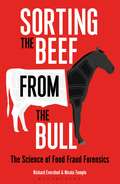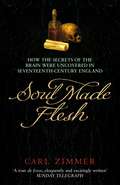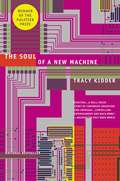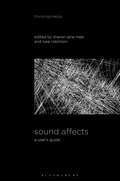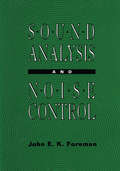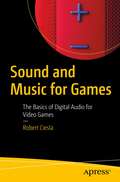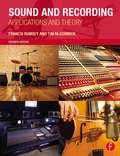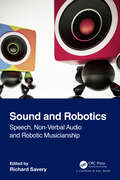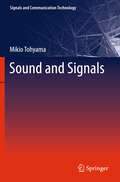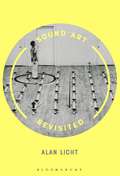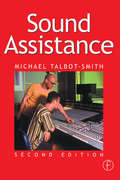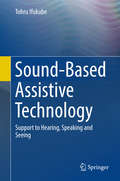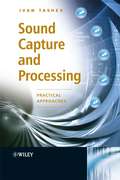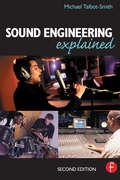- Table View
- List View
Sorghum and Millets Diseases
by John F. LeslieThis work is based on the Mexico 2000 meeting under the auspices of ICRISAT (International Crops Research Institute for Semi-Arid Tropics) and INTSORMIL (International Sorghum and Millet Collaborative Research Support Program). Sorghum and millet are very important agronomic crops in many parts of the world, specifically in the semi-arid regions in warm areas. The crops are of great significance in supplying food and feed in the developing areas of Latin America, Africa, and Asia.
The Sorghum Genome (Compendium of Plant Genomes)
by Sujay Rakshit Yi-Hong WangThis book provides insights into the current state of sorghum genomics. It particularly focuses on the tools and strategies employed in genome sequencing and analysis, public and private genomic resources and how all this information is leading to direct outcomes for plant breeders. The advent of affordable whole genome sequencing in combination with existing cereal functional genomics data has enabled the leveraging of the significant novel diversity available in sorghum, the genome of which was fully sequenced in 2009, providing an unmatched resource for the genetic improvement of sorghum and other grass species. Cultivated grain sorghum is a food and feed cereal crop adapted to hot and dry climates, and is a staple for 500 million of the world’s poorest people. Globally, sorghum is also an important source of animal feed and forage, an emerging biofuel crop and model for C4 grasses, particularly genetically complex sugarcane.
Sorghum in the 21st Century: Food – Fodder – Feed – Fuel for a Rapidly Changing World
by Vilas A. Tonapi Harvinder Singh Talwar Ashok Kumar Are B. Venkatesh Bhat Ch. Ravinder Reddy Timothy J. DaltonSorghum is the most important cereal crop grown in the semi-arid tropics (SAT) of Africa, Asia, Australia and Americas for food, feed, fodder and fuel. It is the fifth most important cereal crop globally after rice, wheat, maize and barley, and plays a major role in global food security. Sorghum is consumed in different forms for various end-uses. Its grain is mostly used directly for food purposes. After the release of the proceedings of two international symposia in the form of books “Sorghum in Seventies” and “Sorghum in Eighties”, global sorghum research and development have not been documented at one place. Of course, few books on sorghum have been released that focus on specific issues/research areas, but comprehensive review of all aspects of recent development in different areas of sorghum science has not been compiled in the form a single book. This book is intended to fill in a void to bridge the gap by documenting all aspects of recent research and development in sorghum encompassing all the progress made, milestones achieved across globe in genetic diversity assessment, crop improvement and production, strategies for high yield, biotic and abiotic stress resistance, grain and stover quality aspects, storage, nutrition, health and industrial applications, biotechnological applications to increase production, including regional and global policy perspectives and developmental needs. This book will be an institutional effort to compile all the latest information generated in research and development in sorghum across the globe at one place.
Sorghum Molecular Breeding
by R. Madhusudhana P. Rajendrakumar J. V. PatilThis book provides an up-to-date overview of international research work on sorghum. Its comprehensive coverage of our current understanding of transgenic development in sorghum and the strategies that are being applied in molecular breeding make this book unique. Important areas such as genetic diversity, QTL mapping, heterosis prediction, genomic and bioinformatics resources, post-genome sequencing developments, molecular markers development using bioinformatics tools, genetic transformation and transgenic research are also addressed. The availability of the genome sequence along with other recent developments in sequencing and genotyping technologies has resulted in considerable advances in the area of sorghum genomics. These in turn have led to the generation of a large number of DNA-based markers and resulted in the identification and fine mapping of QTL associated with grain yield, its component traits, biotic and abiotic stress tolerance as well as grain quality traits in sorghum. Though a large volume of information has accumulated over the years, especially following the sequencing of the sorghum genome, until now it was not available in a single reference resource. This book fills that gap by documenting advances in the genomics and transgenic research in sorghum and presenting critical reviews and future prospects. “Sorghum Molecular Breeding” is an essential guide for students, researchers and managers who are involved in the area of molecular breeding and transgenic research in sorghum and plant biologists in general.
Sortier- und Verteilsysteme: Grundlagen, Aufbau, Berechnung und Realisierung (VDI-Buch)
by Dirk Jodin Michael HompelZunehmende Sendungszahlen und kürzere Laufzeiten in engmaschiger werdenden Logistiknetzwerken sind ohne automatische Sortier- und Verteilsysteme nicht realisierbar. Die entstehenden integrierten und hoch entwickelten Materialflusssysteme sind bisher nur punktuell ingenieurwissenschaftlich aufbereitet worden. Das Buch behandelt erstmals übergreifend die aus Sicht der Sortiersysteme relevanten Themen der beteiligten Disziplinen. Neben der systemtechnischen Einordnung und Definition der betreffenden Anlagen, Geräte und Komponenten werden die am Markt und in den Entwicklungslaboren bekannten Lösungen systematisch vorgestellt. Hersteller, Betreiber und Studierende der Logistik und Ingenieurwissenschaften erhalten mit diesem Buch eine breite Palette an Informationen: Von übergreifenden System- und Strategiebetrachtungen über Funktionsbeschreibungen der Geräte und Komponenten bis hin zu den einschlägigen Berechnungsmethoden. Praxisbeispiele realisierter Anlagen ermöglichen den Einblick in die Vielfältigkeit der Anwendungen moderner Stückgutsortier- und Verteilsysteme.
Sortier- und Verteilsysteme: Grundlagen, Aufbau, Berechnung und Realisierung (VDI-Buch)
by Dirk Jodin Michael HompelAngesichts steigender Sendungszahlen und immer kürzerer Lieferzeiten sind Unternehmen auf automatische Sortier- und Verteilsysteme angewiesen. Zu diesen Materialflusssystemen liefern die Autoren erstmals einen umfassenden und disziplinübergreifenden Überblick: über Systeme, Geräte und Komponenten. Sie beschreiben ihre systemtechnische Morphologie, aber auch grundlegende Funktionen und Berechnungsverfahren und stellen Lösungen vor, die am Markt und in den Entwicklungslaboren vorhanden sind. Mit zahlreichen Abbildungen, Skizzen und Tabellen.
Sorting the Beef from the Bull: The Science of Food Fraud Forensics
by Richard Evershed Nicola TempleHorsemeat in burgers was hard to swallow, but there are far more sinister culinary crimes afoot...Chicken eggs that haven't come from chickens, melamine in infant's milk in China, nut shells in spices – these are just some examples of the food fraud that has occurred in recent years. As our urban lifestyle takes us further and further away from our food sources, there are increasing opportunities for dishonesty, duplicity and profit-making short-cuts. Food adulteration, motivated by money, is an issue that has spanned the globe throughout human history. Whether it's a matter of making a good quality oil stretch a bit further by adding a little extra 'something' or labelling a food falsely to appeal to current consumer trends – it's all food fraud, and it costs the food industry billions of dollars each year. The price to consumers may be even higher, with some paying for these crimes with their health and, in some cases, their lives.Sorting the Beef from the Bull is a collection of food fraud tales from around the world. It explains the role of science in uncovering some of the century's biggest food scams, and explores the arms race between food forensics and fraudsters as new methods of detection spur more creative and sophisticated means of committing the crimes. This book equips us with the knowledge of what is possible in the world of food fraud and shines a light on the shady areas of our food supply system where these criminals lurk.
Soul Made Flesh: How The Secrets of the Brain were uncovered in Seventeenth Century England
by Carl ZimmerAt the beginning of Europe's turbulent seventeenth century, no one knew how the brain worked. By the century's close, the science of the brain had taken root, helping to overturn many common misconceptions about the human body as well as to unseat centuries-old philosophies of man and God. Presiding over this evolution was the founder of modern neurology, Thomas Willis, a fascinating, sympathetic, even heroic figure who stands at the centre of an extraordinary group of scientists and philosophers known as the 'Oxford circle'. Chronicled here in vivid detail are their groundbreaking revelations and often gory experiments that first enshrined the brain as the chemical engine of reason, emotion, and madness - indeed as the very seat of the human soul.
The Soul of A New Machine (Modern Library)
by Tracy KidderTracy Kidder's "riveting" (Washington Post) story of one company's efforts to bring a new microcomputer to market won both the Pulitzer Prize and the National Book Award and has become essential reading for understanding the history of the American tech industry. Computers have changed since 1981, when The Soul of a New Machine first examined the culture of the computer revolution. What has not changed is the feverish pace of the high-tech industry, the go-for-broke approach to business that has caused so many computer companies to win big (or go belly up), and the cult of pursuing mind-bending technological innovations.The Soul of a New Machine is an essential chapter in the history of the machine that revolutionized the world in the twentieth century. "Fascinating...A surprisingly gripping account of people at work." --Wall Street Journal
Sound Affects: A User's Guide (Thinking Media)
by Sharon Jane Mee and Luke RobinsonSound Affects: A User's Guide is a collection of sonically-charged concepts ranging from those felt, 'heard' and repeated (silence, the oriental riff, shuffle), to the vocal (whispers, sing, the disembodied voice), to sounds at the threshold (tin/ny, thump, buzz) to sounds beyond the limits of audibility (inaudible tremors, distortion, sub-bass). Sound Affects invites the reader to reflect on the ways that sounds produce affects and the ways that affects can operate as sound. Each of the entries develops a particular perspective on sound and affect through a close analysis of audiovisual and/or sonic objects. The objects chosen not only illustrate the concept in question but also demonstrate how the object encourages us to rethink the relationships between sounds and affects. Influenced by the sound theory of Eugenie Brinkema (2011), the concepts of Sound Affects plot the shift in volume from silence that opens up a space to be heard to the audibly near, from the audibly near to sounds beyond the limits of audibility. Sound Affects is an intellectual adventure for those who theorize and listen. The book can also be enjoyed as a narrative of sounds, its absences and its shifting intensities.
Sound Affects: A User's Guide (Thinking Media)
Sound Affects: A User's Guide is a collection of sonically-charged concepts ranging from those felt, 'heard' and repeated (silence, the oriental riff, shuffle), to the vocal (whispers, sing, the disembodied voice), to sounds at the threshold (tin/ny, thump, buzz) to sounds beyond the limits of audibility (inaudible tremors, distortion, sub-bass). Sound Affects invites the reader to reflect on the ways that sounds produce affects and the ways that affects can operate as sound. Each of the entries develops a particular perspective on sound and affect through a close analysis of audiovisual and/or sonic objects. The objects chosen not only illustrate the concept in question but also demonstrate how the object encourages us to rethink the relationships between sounds and affects. Influenced by the sound theory of Eugenie Brinkema (2011), the concepts of Sound Affects plot the shift in volume from silence that opens up a space to be heard to the audibly near, from the audibly near to sounds beyond the limits of audibility. Sound Affects is an intellectual adventure for those who theorize and listen. The book can also be enjoyed as a narrative of sounds, its absences and its shifting intensities.
Sound Analysis and Noise Control
by John ForemanThis book has been written to provide an intro Chapter 2 deals with the mechanism of hear duction to the fundamental concepts of sound ing and the subjective rating of sound, includ and a comprehensive coverage whereby un ing age-related and noise-induced hearing loss. wanted sound (noise) can be controlled. Al Assessment of any noise problem involves a though there are many notable textbooks which knowledge of the instrumentation available for deal primarily with the physics (or theory) of measurements, the limitations of this instru sound, and others which treat noise control in mentation, the appropriate procedures for mak a strictly practical (and sometimes even empir ing the measurements with the instrumentation, ical) manner, there are few textbooks that pro and the methods by which the measured data vide a bridging between the necessary under can be analyzed. Chapter 3 provides an up-to standing of the fundamentals of sound (its date coverage of these requirements, including generation, propagation, measurement) and the a section on one of the newest and most valu application of these fundamentals to its control. able tools in noise studies-sound intensity This book provides that link. measurement. The capability of being able to The text presents noise control primarily at measure sound intensity as compared with con the introductory level.
Sound and Music for Games: The Basics of Digital Audio for Video Games
by Robert CieslaGrasp the fundamentals of digital audio work in the context of video games, including the basics of middleware such as Fmod and Wwise. We will review software such as Apple's Logic and Garageband, Paul Davis's Ardour, and many other popular digital audio workstations. We will start with an introduction to the basic terminology of digital audio work while also getting acquainted with current generation audio hardware. We will then discuss the basics of the venerable Musical Instrument Digital Interface (MIDI) and how it relates to music composition as well as the tools and techniques for writing tracker music/chiptunes. The book also covers plug-in software, soundproofing at home, and voice work. The book takes a practical approach while tackling both hardware and software components used in cutting edge audio engineering, composition, and audio monitoring. What You Will Learn • Understand the fundamentals of digital audio production in the context of video games • Learn about audio integration with popular middleware solutions and APIs • Leverage plugin effects software to sculpt your audio to professional levels • Identify modern audio file formats and how and when to use them • Learn best practices when mixing sound effects and music for video games Who Is This Book For The intended readership includes beginners in digital audio engineering who use Windows, macOS, or Linux.
Sound and Recording: Applications and Theory (Focal Press Music Technology Ser.)
by Francis Rumsey Tim McCormickProviding vital reading for audio students and trainee engineers, this guide is ideal for anyone who wants a solid grounding in both theory and industry practices in audio, sound and recording. There are many books on the market covering "how to work it" when it comes to audio equipment—but Sound and Recording isn’t one of them. Instead, you’ll gain an understanding of "how it works" with this approachable guide to audio systems. New to this edition: Digital audio section revised substantially to include the latest developments in audio networking (e.g. RAVENNA, AES X-192, AVB), high-resolution surround and parametric audio coding, workstation processing technology, mastering for iTunes, and loudness normalization Coverage of immersive audio systems such as Dolby Atmos, Auro 3D and WFS along with recent developments in audio object coding Sections on digital radio microphones, loudspeaker sensitivity issues and development, and highly directional loudspeaker systems Substantial new sections on recent developments in audio network device discovery and control and the Open Control Architecture
Sound and Recording: Applications and Theory
by Francis Rumsey Tim McCormickProviding vital reading for audio students and trainee engineers, this guide is ideal for anyone who wants a solid grounding in both theory and industry practices in audio, sound and recording. There are many books on the market covering "how to work it" when it comes to audio equipment—but Sound and Recording isn’t one of them. Instead, you’ll gain an understanding of "how it works" with this approachable guide to audio systems. New to this edition: Digital audio section revised substantially to include the latest developments in audio networking (e.g. RAVENNA, AES X-192, AVB), high-resolution surround and parametric audio coding, workstation processing technology, mastering for iTunes, and loudness normalization Coverage of immersive audio systems such as Dolby Atmos, Auro 3D and WFS along with recent developments in audio object coding Sections on digital radio microphones, loudspeaker sensitivity issues and development, and highly directional loudspeaker systems Substantial new sections on recent developments in audio network device discovery and control and the Open Control Architecture
Sound and Robotics: Speech, Non-Verbal Audio and Robotic Musicianship
by Richard SaverySound in human–robot interaction currently encompasses a wide range of approaches and methodologies not easily classified, analyzed or compared among projects. This edited book covers the state of the art in sound and robotics, aiming to gather existing approaches in a combined volume. Collecting chapters from world-leading academic and industry authors, Sound and Robotics: Speech, Non-Verbal Audio and Robotic Musicianship explores how robots can communicate through speech, non-verbal audio and music. The first set of chapters explores how robots use verbal communication, considering the possibilities of speech for human–robot interaction. The second section shifts to roles of non-verbal communication in HRI, including consequential sound, sonification and audio cues. The third and final section describes current approaches to robotic musicianship and their evaluation. This book is primarily aimed at HRI researchers, ranging from those who have never used sound to those very experienced with sound. Alongside robotic researchers, this book will present avenues for a diverse range of musicians, composers and sound designers to become introduced to the world of HRI and learn of potential creative directions in robotics.
Sound and Robotics: Speech, Non-Verbal Audio and Robotic Musicianship
Sound in human–robot interaction currently encompasses a wide range of approaches and methodologies not easily classified, analyzed or compared among projects. This edited book covers the state of the art in sound and robotics, aiming to gather existing approaches in a combined volume. Collecting chapters from world-leading academic and industry authors, Sound and Robotics: Speech, Non-Verbal Audio and Robotic Musicianship explores how robots can communicate through speech, non-verbal audio and music. The first set of chapters explores how robots use verbal communication, considering the possibilities of speech for human–robot interaction. The second section shifts to roles of non-verbal communication in HRI, including consequential sound, sonification and audio cues. The third and final section describes current approaches to robotic musicianship and their evaluation. This book is primarily aimed at HRI researchers, ranging from those who have never used sound to those very experienced with sound. Alongside robotic researchers, this book will present avenues for a diverse range of musicians, composers and sound designers to become introduced to the world of HRI and learn of potential creative directions in robotics.
Sound and Signals (Signals and Communication Technology)
by Mikio TohyamaThis is an up-to-date reference and textbook on modern acoustics from a signal-theoretic point of view, as well as a wave-theoretic approach for students, engineers, and researchers. It provides readers the fundamental basis of acoustics and vibration science and proceeds up to recent hot topics related to acoustic transfer functions and signal analysis including a perceptual point of view.In the first part, the work uniquely introduces into the fundamentals without using heavy mathematics The following, advanced chapters deal with new and deep insights into acoustic signal analysis and investigation of room transfer functions based on the poles and zeros.
Sound Art Revisited
by Alan LichtThe first edition of Sound Art Revisited (published as Sound Art: Beyond Music, Between Categories) served as a groundbreaking work toward defining this emerging field, and this fully updated volume significantly expands the story to include current research since the book's initial release. Viewed through a lens of music and art histories rather than philosophical theory, it covers dozens of artists and works not found in any other book on the subject. Locating sound art's roots across the centuries from spatialized church music to the technological developments of radio, sound recording, and the telephone, the book traces the evolution of sound installations and sound sculpture, the rise of sound art exhibitions and galleries, and finally looks at the critical cross-pollination that marks some of the most important and challenging art with and about sound being produced today.
Sound Art Revisited
by Alan LichtThe first edition of Sound Art Revisited (published as Sound Art: Beyond Music, Between Categories) served as a groundbreaking work toward defining this emerging field, and this fully updated volume significantly expands the story to include current research since the book's initial release. Viewed through a lens of music and art histories rather than philosophical theory, it covers dozens of artists and works not found in any other book on the subject. Locating sound art's roots across the centuries from spatialized church music to the technological developments of radio, sound recording, and the telephone, the book traces the evolution of sound installations and sound sculpture, the rise of sound art exhibitions and galleries, and finally looks at the critical cross-pollination that marks some of the most important and challenging art with and about sound being produced today.
Sound Assistance
by Michael Talbot-SmithSound Assistance offers a highly readable and easy-to-understand account of sound operations in radio and television studios. By knowing the characteristics of the equipment, such as threshold and compression ratios, it is much easier to achieve professional effects quickly, saving hours of trial and error. The book will suit anyone wishing to work as a sound assistant but who does not have a thorough grounding in the maths and physics. Written in an informal style with practical 'do's' and 'don'ts', the fundamental principles are explained. Where knowledge of a higher level of maths is helpful, this information is given in handy 'fact files'.Particularly appropriate for students, training officers and supervisors who have the task of passing on this information in a simple, easy-to-digest format, Sound Assistance is written in easy-to read language with a minimum of maths.This second edition now has more on:* Microphone sensitivities* Loudspeaker listening tests* Domestic colour code for stereo* Stereo transmission in radio* Stereo PPM interpretations* MiniDisk* Digital radio* Recordable CDs.Michael Talbot-Smith is a freelance audio consultant and author of Audio Explained, and coauthor of The Video Studio. He is editor of The Audio Engineer's Reference Book (now in its second edition) and The Sound Engineer's Pocketbook. He is a former trainer of audio engineers at BBC Wood Norton.
Sound Assistance
by Michael Talbot-SmithSound Assistance offers a highly readable and easy-to-understand account of sound operations in radio and television studios. By knowing the characteristics of the equipment, such as threshold and compression ratios, it is much easier to achieve professional effects quickly, saving hours of trial and error. The book will suit anyone wishing to work as a sound assistant but who does not have a thorough grounding in the maths and physics. Written in an informal style with practical 'do's' and 'don'ts', the fundamental principles are explained. Where knowledge of a higher level of maths is helpful, this information is given in handy 'fact files'.Particularly appropriate for students, training officers and supervisors who have the task of passing on this information in a simple, easy-to-digest format, Sound Assistance is written in easy-to read language with a minimum of maths.This second edition now has more on:* Microphone sensitivities* Loudspeaker listening tests* Domestic colour code for stereo* Stereo transmission in radio* Stereo PPM interpretations* MiniDisk* Digital radio* Recordable CDs.Michael Talbot-Smith is a freelance audio consultant and author of Audio Explained, and coauthor of The Video Studio. He is editor of The Audio Engineer's Reference Book (now in its second edition) and The Sound Engineer's Pocketbook. He is a former trainer of audio engineers at BBC Wood Norton.
Sound-Based Assistive Technology: Support to Hearing, Speaking and Seeing
by Tohru IfukubeThis book presents a technology to help speech-, hearing- and sight-impaired people. It explains how they will benefit from an enhancement in their ability to recognize and produce speech or to detect sounds in their surroundings. Additionally, it is considered how sound-based assistive technology might be applied to the areas of speech recognition, speech synthesis, environmental recognition, virtual reality and robots. The primary focus of this book is to provide an understanding of both the methodology and basic concepts of assistive technology rather than listing the variety of assistive devices developed. This book presents a number of different topics which are sufficiently independent from one another that the reader may begin at any chapter without lacking background information. Much of the research quoted in this book was conducted in the author's laboratories at Hokkaido University and University of Tokyo. This book offers the reader a better understanding of a number of unsolved problems that still persist in the field of sound-based assistive technology.
Sound Capture and Processing: Practical Approaches
by Ivan Jelev TashevProvides state-of-the-art algorithms for sound capture, processing and enhancement Sound Capture and Processing: Practical Approaches covers the digital signal processing algorithms and devices for capturing sounds, mostly human speech. It explores the devices and technologies used to capture, enhance and process sound for the needs of communication and speech recognition in modern computers and communication devices. This book gives a comprehensive introduction to basic acoustics and microphones, with coverage of algorithms for noise reduction, acoustic echo cancellation, dereverberation and microphone arrays; charting the progress of such technologies from their evolution to present day standard. Sound Capture and Processing: Practical Approaches Brings together the state-of-the-art algorithms for sound capture, processing and enhancement in one easily accessible volume Provides invaluable implementation techniques required to process algorithms for real life applications and devices Covers a number of advanced sound processing techniques, such as multichannel acoustic echo cancellation, dereverberation and source separation Generously illustrated with figures and charts to demonstrate how sound capture and audio processing systems work An accompanying website containing Matlab code to illustrate the algorithms This invaluable guide will provide audio, R&D and software engineers in the industry of building systems or computer peripherals for speech enhancement with a comprehensive overview of the technologies, devices and algorithms required for modern computers and communication devices. Graduate students studying electrical engineering and computer science, and researchers in multimedia, cell-phones, interactive systems and acousticians will also benefit from this book.
Sound Engineering Explained
by Michael Talbot-SmithThis straightforward introduction to audio techniques guides the beginner through principles such as sound waves and basic acoustics and offers practical advice for using recording and reproduction equipment. Previously known as Audio Explained, this latest edition includes new material on: reverberation and its use in recording; principles of digital mixing; digital recording; including MiniDisc and MP3; digital artificial reverberation. Designed with the student in mind, information is organised according to level of difficulty. An understanding of the basic principles is essential to anyone wishing to make successful recordings and so chapters are split into two parts: the first introducing the basic theories in a non-technical way; the second dealing with the subject in more depth. Key facts are clearly identified in separate boxes and further information for the more advanced reader is indicated in shaded boxes. In addition, questions are provided (with answers supplied at the end of the book) as a teaching and learning aid.Sound Engineering Explained is ideal for both serious audio amateurs any student studying audio for the first time, in particular those preparing for Part One exams of the City & Guilds Sound Engineering (1820) course.
